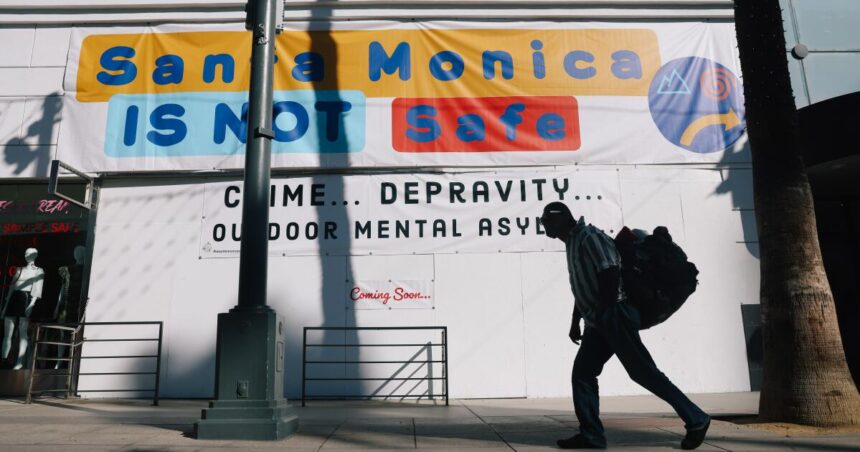
Homeless people in Santa Monica may no longer be sleeping outside as the city considers changing its anti-camping ordinance to comply with a U.S. Supreme Court ruling on the controversial topic.
Existing regulations prohibit tents and emergency shelters on public property. The revised ordinance would also prohibit unprotected city residents from using blankets, pillows and bedrolls when sleeping outside, an exemption that was added in 2022 to comply with an appeals court ruling.
Santa Monica officials were expected to discuss the proposed ordinance along with other recommendations during Tuesday night’s City Council meeting, but officials delayed the items to be discussed as early as next week.
Homeless people have long been drawn to Santa Monica, especially to the promenade and beaches where tourists flock. He has been blamed for several headline-grabbing crimes.
Last summer, an apparently homeless man attacked Mayor Phil Brock on the Third Street Promenade. Brock was a councilor at the time of the attack. Last May, a homeless man attacked three people on the same street, stabbing at least two German tourists. The following month, Santa Monica police arrested a homeless man who assaulted three people on the beach, including an elderly woman and a 17-year-old girl.
There were 774 homeless people in Santa Monica, down 6% from 826 in 2023, according to the city’s latest homeless count. At least 62% of the homeless population lives outdoors.
Tuesday’s proposed ordinance drew dozens of residents to the Santa Monica council chambers, some of whom spoke about the matter at the start of the meeting.
Wade Kelly, a resident, told the council during public comment that he disagreed with the city’s plan to ban people from sleeping outdoors and spoke to the mayor directly.
“You don’t support human rights,” Kelly said.
Brock didn’t hesitate to respond back to his words.
“I like the citizens, I have business interests and I like the people who need compassion on our streets,” he said. “The question is, (is it) compassion for people to live on the streets and die – I’m inclined to say it’s indifference, not compassion.”
Several residents wrote to elected officials to express their disapproval of the proposed ordinance; among them was resident Patricia Meyer.
“To simultaneously refuse blankets and alternative places for unhoused people to sleep is both mean and absurd,” she wrote.
Kathleen Sheldon, a longtime resident, also wrote to officials, saying preventing people from sleeping outside will not eliminate the homeless problem.
“This will only expose the desperate to more inhumane conditions, more dangerous to their health and safety and possibly their lives,” he wrote. “Please do not give in to the loudest and most hateful voices in our community. Instead, withdraw these cruel and counterproductive proposals and do what is best for our city.
The proposed ordinance to be considered Tuesday night stems from a July City Council meeting where Mayor Pro Tem Lana Negrete and Councilman Oscar de la Torre asked city staff to “evaluate and provide options to amend the city’s municipal code” to comply. with a recent US Supreme Court decision.
In June, the state’s high court overturned the ruling by ACE Circuit 9 Court of Appeal, known as the Grant Pass decision. The ruling said the camping and sleeping ordinances violated the 8th Amendment by inflicting cruel and unusual punishment on people who had nowhere else to live.
The Supreme Court’s decision to overturn the Grant Pass decision means cities and counties are free to ban people from sleeping or camping on public property, even if they have nowhere else to go.
Shortly after the decision, Governor Gavin Newsom directed state agencies to begin clearing homeless encampments from state land; He urged the city and county to do the same and threatened to take money away from the city and county that do not make progress in cleaning up homeless camps.
Last week, the city of Long Beach started implement its anti-camping laws by giving the police full discretion to issue citations and make arrests if necessary. City officials are also seeking to remove homeless encampments that pose a threat to public health and safety and prevent people from accessing libraries, parks and beaches. Authorities are also targeting camps where people have resisted services.
In Los Angeles, elected officials said the governor’s order did not change anything in their approach to clearing the encampment.
While it’s unclear what Santa Monica’s elected officials plan to do, city staff have made other recommendations, including taking no action. The city’s anti-camping ordinance currently prohibits tents and emergency shelters on public property but allows people to use blankets and pillows while sleeping.
Staff also suggested the city wait and see how other cities approach homeless encampments amid the Supreme Court ruling.
Tuesday’s controversial proposal also came on the eve of city officials considering buying a commercial building in the 1400 block of Wilshire Boulevard to use for a permanent supportive housing project.
Many residents who live around the proposed site objected to the project saying it would make the neighborhood more dangerous and inconvenience shoppers while affecting businesses.
“We need to do something to help the homeless,” Mary Stewart, an apartment owner, told the council. “It’s actually not going to do anything, it’s going to destroy the environment which is not good for anybody.”
He and many other residents said they would be okay with the project as long as the tenants are low-income seniors.
George Guttman echoed those sentiments, but also offered additional advice to city leaders.
“If you’re going to build affordable housing, hopefully you can put your family there so they can go to a good school.”




